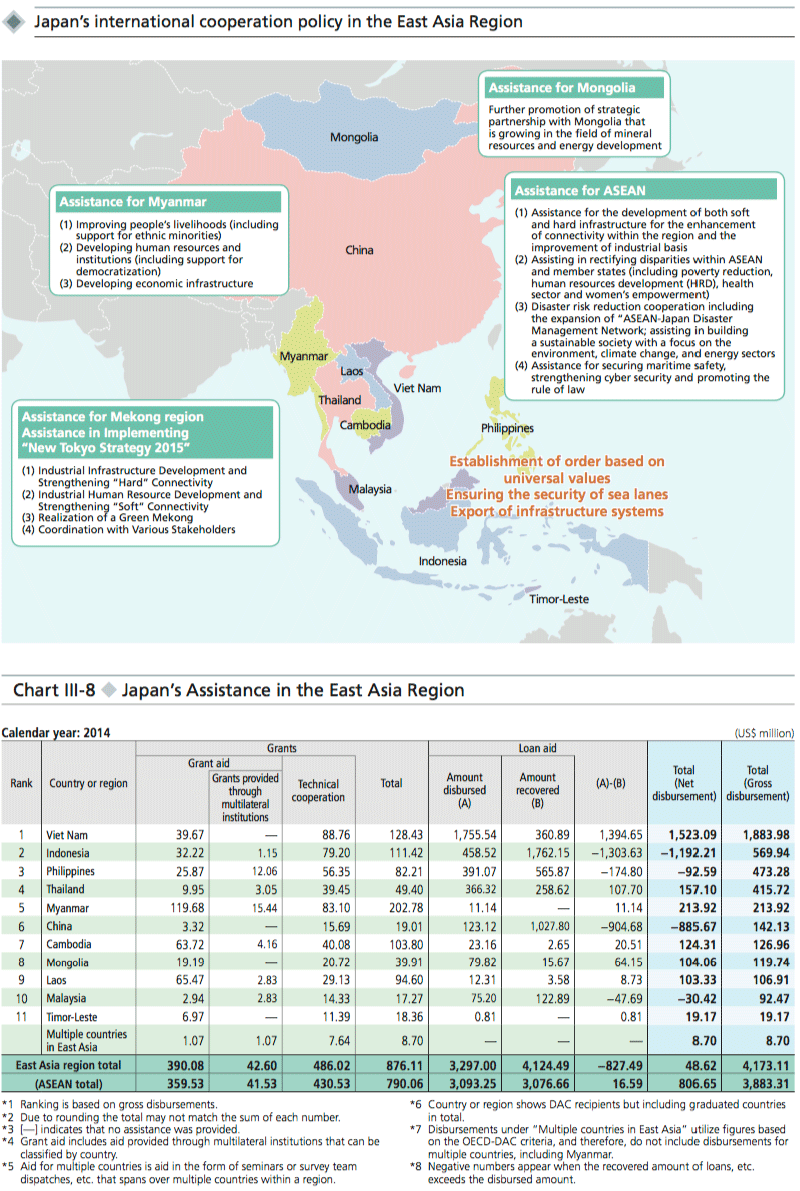Section 2 Assistance for Each Region
Challenges and problems vary according to country and region. In view of the increasingly diverse, complex, and broader-based development challenges and the progress in globalization in the international community today, it is necessary to implement cooperation that caters to the needs and characteristics of each region while maintaining a global perspective. Based on an understanding of the economic and social backgrounds of these problems, Japan strives to solve the problems facing developing countries by providing more focused development cooperation in a strategic, effective, and agile manner while coping flexibly with ever changing situations.

1. East Asia
East Asia consists of a variety of nations: countries such as the Republic of Korea and Singapore, which have attained high economic growth and have already shifted from aid recipients to donors; least developed countries (LDCs) such as Cambodia and Laos; countries such as Indonesia and the Philippines, which still have internal disparities despite their dramatic economic growth; and countries such as Viet Nam, which is in the process of transitioning from a centrally planned economy to a market economy. Japan has close relationships with these countries in all aspects of politics, economy, and culture, so the development and stability of the region significantly impacts the security and prosperity of Japan as well. From this perspective, Japan is engaging in development cooperation activities that respond not only to the diverse socio-economic circumstances of East Asian countries, but also to the changes in the type of development cooperation that is required.
< Japan’s Efforts >
Japan has contributed to the remarkable economic growth in East Asia by implementing development cooperation that combines ODA with trade and investment, including the improvement of infrastructure, development of institutions and human resources, promotion of trade, and revitalization of private investment. Currently, Japan is aiming to further enhance open regional cooperation and integration while sharing basic values, to promote mutual understanding, and to maintain consistent regional stability. Therefore, Japan has made efforts to proactively provide assistance in an array of areas such as disaster risk reduction, environment and climate change, strengthening of the rule of law, health and medical care, and maritime safety, in parallel with the assistance for developing infrastructure to date. Japan is also working to promote mutual understanding through large-scale youth exchanges, cultural exchanges, and projects to disseminate Japanese language education.
In order for Japan and other East Asian countries to achieve further prosperity, it is important to assist Asia to become “a center of growth open to the world.” Accordingly, Japan is providing assistance to strengthen Asia’s growth and to expand domestic demand in each country.
| Support for Southeast Asia
The member states of the Association of Southeast Asian Nations (ASEAN)(Note 1) are pivotal countries for Japan on both the political and economic fronts, as they are located on its sea lanes and have strong economic ties with Japan, with many Japanese companies entering the region’s markets. ASEAN had been strengthening connectivity and narrowing gaps within the region in order to achieve the top objective of establishing an ASEAN Community in 2015. In light of ASEAN’s efforts, Japan provides ODA supports in a range of areas based on the pillars of strengthening connectivity and narrowing gaps. These areas include infrastructure development, strengthening rule of law, maritime safety, disaster risk reduction, health and medical care, and peacebuilding.
With regard to strengthening connectivity, at the ASEAN Summit Meeting held in October 2010, ASEAN adopted the Master Plan on ASEAN Connectivity,* aiming to intensify physical connectivity, institutional connectivity, and people-to-people connectivity in the region. In light of this, Japan has utilized ODA and public-private partnership (PPP) to provide proactive assistance to put the Master Plan into action. In addition, Japan promotes the development of physical infrastructure, including roads and bridges, railways, airports, and ports, as well as institutions and non-physical infrastructure, such as improving customs systems. These activities are carried out based on a twofold concept of building the East-West and Southern Economic Corridors in the Mekong region, and building the Maritime ASEAN Economic Corridor in Indonesia, Malaysia, the Philippines, and other countries.
In 2013, which marked the 40th year of ASEAN-Japan friendship and cooperation, the Vision Statement on ASEAN-Japan Friendship and Cooperation was adopted at the ASEAN-Japan Commemorative Summit Meeting in Tokyo in December. The statement presented medium- to long- term visions for deepening ASEAN-Japan relations. On this occasion, Japan pledged ¥2 trillion of ODA assistance over five years based on the pillars of “strengthening connectivity” and “narrowing gaps” which ASEAN identifies for establishing the ASEAN Community in 2015. In the area of disaster risk reduction, Japan unveiled the Package for Strengthening ASEAN-Japan Disaster Management Cooperation in response to the catastrophic devastation caused by Typhoon Yolanda in the central Philippines in November 2013. The package included expanding the disaster risk reduction network and implementing support for realizing disaster-resilient societies. As part of this package, Japan announced assistance of ¥300 billion and human resources development for 1,000 people over five years, with the objective of improving the disaster response capacities of ASEAN and developing its quality infrastructure for disaster risk reduction.
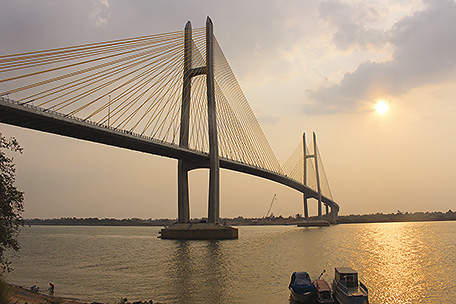
The Neak Loeung Bridge prior to its opening to traffic, after the removal of the construction cranes. The bridge was named Tsubasa Bridge because it looks like two birds spreading their wings (tsubasa in Japanese). (Photo: Shinichi Kuno / JICA)
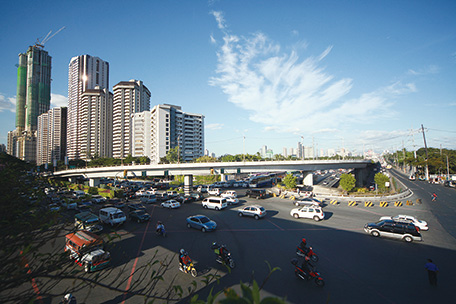
An interchange built in the business district of the City of Makati, the Philippines, as part of the Metro Manila Interchange Construction Project. The interchange contributes to alleviation of traffic congestions. (Photo: Harvey Tapan)
Japan underscores the importance of “quality infrastructure investment” based on its experience with assisting infrastructure development in Southeast Asian countries. At the Japan-ASEAN Summit held in November 2014, Japan announced that to achieve sustainable, inclusive, and resilient “quality growth,” it would carry out infrastructure investment in Southeast Asia by adopting the following four approaches: (i) effective resource mobilization; (ii) strengthening partnerships with aid recipient countries, international organizations, and other partners; (iii) social and environmental consideration as well as life cycle cost; and (iv) comprehensive and tailor-made assistance. The pursuit of “quality infrastructure investment” in ASEAN has made steady gains. For example, in December 2014, construction work was completed for Terminal 2 of Noi Bai International Airport, the air gateway of the Vietnamese capital of Hanoi. In April 2015, an opening ceremony was held for Neak Loeung Bridge (commonly known as “Tsubasa Bridge”), the key element of the Southern Economic Corridor in Cambodia. To advance these efforts, Prime Minister Shinzo Abe announced the Partnership for Quality Infrastructure: Investment for Asia’s Future(Note 2) at the 21st International Conference on the Future of Asia held in Tokyo in May 2015. Prime Minister Abe announced that Japan would collaborate with the Asian Development Bank (ADB) to provide “quality infrastructure investment” in Asia at a scale of approximately $110 billion in total over the next five years.

Group photograph of the participants in the 18th ASEAN-Japan Summit held in Kuala Lumpur, Malaysia, in November 2015. (Photo: Cabinet Public Relations Office)
At the Japan-ASEAN Summit in November, Prime Minister Abe announced the follow-up measures of the Partnership for Quality Infrastructure to expand this partnership. The follow-up measures include the improvement of Japanese ODA Loans and Private-Sector Investment Finance, including acceleration of ODA Loan procedures and the establishment of new Japanese ODA Loans, further collaboration with ADB, as well as revising the systems and improving the operations of the Japan Bank for International Cooperation (JBIC) and the Nippon Export and Investment Insurance (NEXI). Furthermore, at the same summit, Prime Minister Abe announced the Industrial Human Resource Development Cooperation Initiative that would train 40,000 industrial human resources over the next three years, based on the view that the development of industrial human resources that are responsible for establishing and upgrading the key industries of each country is indispensable to Asia’s sustainable growth in addition to infrastructure development. Japan will proactively support industrial human resources development in Asia.
Strategies regarding Japan’s assistance for the Mekong region(Note 3) have been adopted at the Mekong-Japan Summit Meeting that is held around once every three years in Japan. Over the past three years, Japan-Mekong cooperation was steadily carried out through the summit and foreign ministers’ meetings held annually, in accordance with the following three pillars of the Tokyo Strategy 2012 for Mekong-Japan Cooperation adopted at the Fourth Mekong-Japan Summit Meeting in April 2012: (i) Enhancing Mekong connectivity; (ii) Promoting trade and investment; and (iii) Ensuring human security and environmental sustainability.
At the Seventh Mekong-Japan Summit Meeting (fourth held in Japan) in July 2015, the New Tokyo Strategy 2015 was adopted to serve as the strategy for Japan-Mekong cooperation over the next three years, consisting of the following four pillars: (i) Industrial infrastructure development in the Mekong region and strengthening “hard connectivity” within the region and with the surrounding regions; (ii) Industrial human resource development and strengthening “soft connectivity”; (iii) The realization of a Green Mekong;(Note 4) and (iv) Coordination with various stakeholders. At the same time, Japan announced that it would implement assistance of ¥750 billion annually over the next three years through ODA to achieve “quality growth” that is also comprehensive, sustainable, and resilient in the Mekong region.
Among the Mekong region countries, efforts are being made to advance democratization, especially in Myanmar. In April 2012, Japan announced that it would review its economic cooperation policy and provide a wide range of assistance to Myanmar to back up the rapid progress of its reform efforts. These include livelihood improvements for residents, such as assistance for ethnic groups, as well as assistance for legal and judicial system development, human resources development, and infrastructure development mainly in the Thilawa Special Economic Zone (SEZ) in Yangon. In this manner, Japan actively provides various kinds of assistance to Myanmar. In May 2014, the sale of leasehold rights for the Class A Area of the Thilawa SEZ started. In September 2015, an opening ceremony was held that was also attended by Deputy Prime Minister Taro Aso.
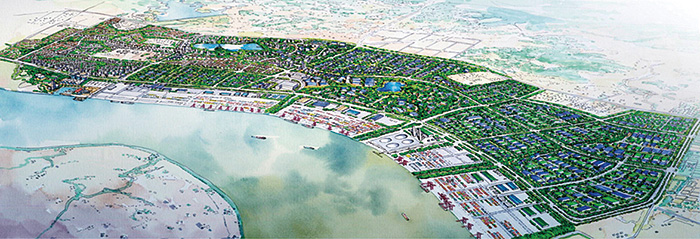
Rendering of the Thilawa Special Economic Zone (SEZ), Myanmar. (Photo: JICA)
- *Master Plan on ASEAN Connectivity
- Master Plan on ASEAN Connectivity is a plan adopted at the October 2010 ASEAN Summit to strengthen connectivity of ASEAN towards building the ASEAN Community by 2015. This enhancement focuses on three types of connectivity: “physical connectivity“ (transport, ICT, energy networks, etc.), ”institutional connectivity“ (liberalization and facilitation of trade, investment, services, etc.), and ”people-to-people connectivity“ (tourism, education, culture, etc.).
- Note 1: ASEAN member states: Brunei, Cambodia, Indonesia, Laos, Malaysia, Myanmar, the Philippines, Singapore, Thailand, and Viet Nam (however, Singapore and Brunei are not ODA recipients).
- Note 2: Partnership for Quality Infrastructure consists of the following four pillars: (i) Expansion and acceleration of assistance through the full mobilization of Japan’s economic cooperation tools; (ii) Collaboration between Japan and ADB; (iii) Measures to double the supply of funding for projects with relatively high risk profiles by such means as the enhancement of the function of JBIC; and (iv) Promoting “Quality Infrastructure Investment” as an international standard (see this).
- Note 3: Mekong countries are Cambodia, Laos, Myanmar, Thailand, and Viet Nam
- Note 4: An initiative between Japan and the Mekong region countries designed to create a “Green Mekong” filled with greenery, rich in biodiversity, and resilient to natural disasters.
| Relations with China
From 1979, Japan began providing ODA for China as one of the pillars of the Japan-China relationship. However, the provision of new ODA Loans and General Grant Aid, which accounted for a large share of Japan’s ODA to China, has already been terminated in light of the significant changes in China’s economy, technologies, and other aspects. Japan’s assistance thus far has contributed to the stable growth of the Chinese economy, and by extension, made a considerable contribution to the stability of the Asia-Pacific region, as well as to improving the investment environment in China for Japanese companies and deepening private-sector economic ties between the two countries.(Note 5)
Currently, ODA to China is limited to technical cooperation for areas which have a genuine need for cooperation, such as cross-border pollution, infectious diseases, and food safety, which directly affect the lives of the Japanese people,(Note 6) and Grant Assistance for Grass-Roots Human Security Project, among other schemes. Technical cooperation, which accounts for a large part of Japan’s ODA to China, is being implemented by phasing in appropriate cost-sharing between Japan and China.
- Note 5: The cumulative totals until FY2014 were as follows: Loan aid ¥3.3165 trillion (commitment base); grant aid ¥157.5 billion (commitment base); and technical cooperation¥183.2 billion (amount disbursed by JICA) (however, the new provision of ODA Loan and General Grant Aid has already been terminated).
- Note 6: In FY2014, Japan implemented technical cooperation projects (technical cooperation disbursements [amount disbursed by JICA]: ¥1.446 billion), such as the “Project for Capacity Development of Planning for Pollution Control of O3 and PM2.5 in Atmosphere.”
Myanmar
The Project for Upgrading Ferryboat in Yangon City
Grant Aid (March 2013 – Ongoing)
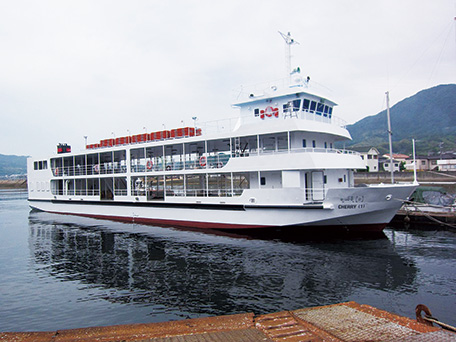
A ferryboat built through this cooperation. (Photo: JICA)
Myanmar has a well-developed inland canal system. The system is comprised of the Irrawaddy River flowing north to south, as well as the river’s tributaries and expansive coastal delta. Myanmar has a population of 51.41 million (as of FY 2014), and it is estimated that over 40% of the population uses inland water transportation. This makes it a key component of the country’s transportation network.
Yangon is Myanmar’s largest city and surrounded by rivers on three sides. A ferry route connects the Dala Township, a residential area, with downtown Yangon, across the Yangon River. It is used by more than 30,000 people each day. The ferries are often over capacity during rush hours in the morning and evening.
However, the ferries in operation were getting old and had widespread minor hull damage, so they frequently experienced water leaks. Therefore, the ferries needed to be repaired in a dry dock for three months each year. This made it difficult to operate according to a consistent schedule. This ferry route is an important mode of transport for many commuters in Yangon, which is growing rapidly. However, inconsistent schedules in its operation could hinder economic growth.
At the request of the Government of Myanmar, the Government of Japan provided three new ferries to replace the aging Yangon River ferry fleet and also improved ferry docks.
Specifically, these three new ferries each have a total length of 41.35 meters, beam of 9.4 meters, draft of 7.4 meters, gross tonnage of 290 tons and passenger capacity of 1,200. In addition, grant aid was used to fund equipment for improving ferry docks, equipment for maintaining the new ferries (one set per ferry), and replacement parts for preventive maintenance (one set per ferry).
These ferries are used by countless locals as a mode of public transport. Improving their service is expected to promote safe and reliable transportation, enhance the living environment for Yangon’s residents, and contribute to realizing a stable society. Yangon is a city that continues to see robust economic development. By improving the city’s transportation network, Japan is helping to improve living standards in Myanmar. (As of August 2015)
Cambodia
The Project for Construction of Neak Loeung Bridge
Grant Aid (June 2010 – Ongoing)
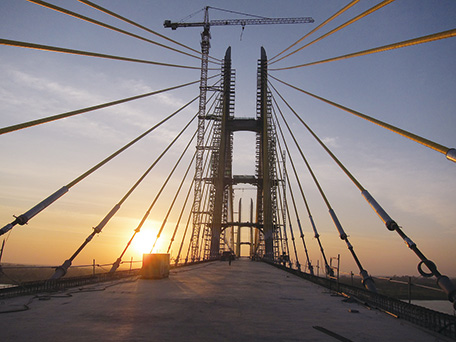
The Tsubasa Bridge. (Photo: JICA)
Cambodia’s National Road 1 forms part of the Asian Highway (AH-1). AH-1 is also known as the Southern Economic Corridor, and is an international trunk route connecting Ho Chi Minh in Viet Nam, Phnom Penh in Cambodia and Bangkok in Thailand. National Road 1 is expected to see a large increase in traffic volume, including industrial vehicles, after the establishment of the ASEAN Economic Community (AEC) at the end of 2015.
However, the only way to cross the Mekong River on National Road 1 was by ferry. Sometimes drivers have to wait for up to seven hours for the ferry during busy times. Moreover, the ferry did not operate from 12:00 am to 5:00 am. This created a bottleneck and shut down the highway for five hours each day.
The Government of Cambodia requested the Government of Japan to construct the 5,460-meter Neak Loeung Bridge across the Mekong River along National Road 1. Cambodia chose Japan because of its positive track record in road development in Cambodia. Japan gave the official go-ahead to build the bridge in 2010.
There were a number of difficulties during construction. For example, a munitions warehouse from the time of Cambodia’s civil war was located close to the construction site. Therefore, more than 4,000 unexploded ordnances had to be dealt with before construction could begin. However, not all of these ordnances were removed, resulting in one explosion. Fortunately, no one was injured in the incident.
Cambodia also experienced record-breaking floods in 2011. These floods swept away a 30-meter section of the riverbank where bridge construction was taking place.
Despite these trials and tribulations, the bridge was finally opened to traffic in April 2015, and named “Tsubasa Bridge.” It is now possible for traffic to cross the Mekong River at all hours of the day without restrictions. The bridge has also greatly improved access to hospitals, schools and places of work for people living nearby. Tsubasa Bridge is expected to facilitate the flow of logistics, transport, and exchange through the Southern Economic Corridor. It will therefore foster further economic development, not only in Cambodia, but also throughout the Mekong Region. (As of August 2015)
